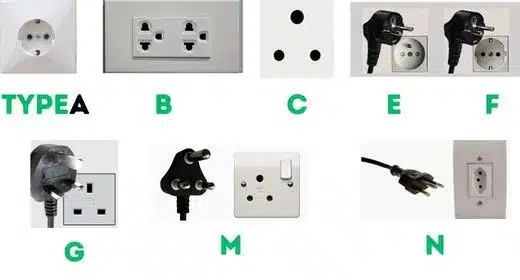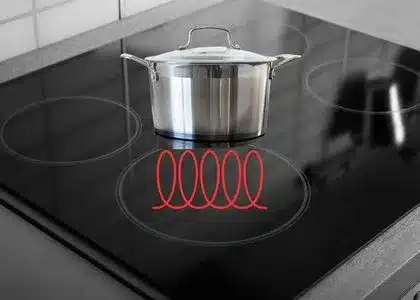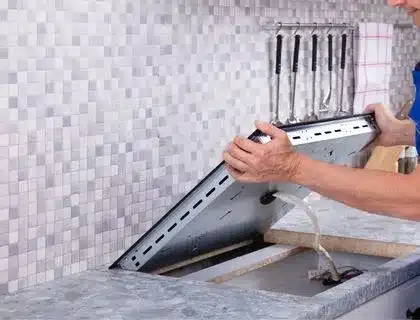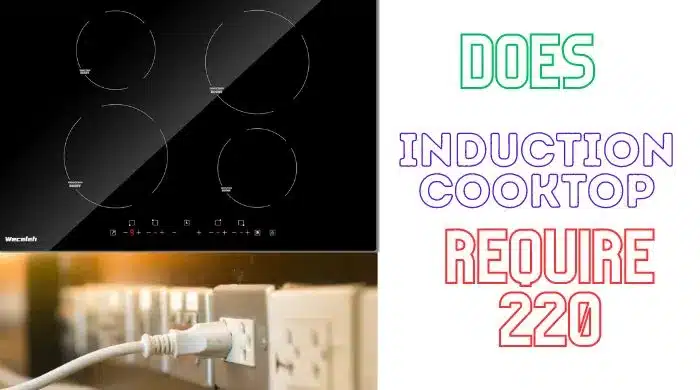Induction cooktops are currently trending as one of the top kitchen appliances. Compared to gas or electric cooktops, they offer efficient and even cooking. However, selecting an induction cooktop involves considering a plethora of features. Nonetheless, a common question is whether induction cooktops require 220 volts, alongside other related inquiries.
Table of Contents
Does Induction Cooktop Require 220
Electronic products are designed to meet regional requirements. For instance, induction cooktops are designed to operate on 120 volts in the USA. However, in Asian countries, manufacturers design their products to work on 220 volts. It’s worth noting that electrical plugs in the US are specifically designed for use within the country.
Since outlets and voltage differ internationally, it’s important to check compatibility before purchasing an induction cooktop.
An adapter or converter at your destination may be necessary if you use an induction cooktop. Therefore, it’s essential to ensure that the product is compatible with the power supply in your area before purchasing to avoid any inconvenience or damage to the appliance.
Here are some standard voltage plans across some countries.
| Country | Single-Phase Voltage | Frequency | Power Plug Type |
| Pakistan | 230 V | 50 Hz | C/D |
| Australia | 230 V | 50 Hz | I |
| Brazil | 127 V / 220 V | 60 Hz | C/N |
| Canada | 120 V | 60 Hz | A/B |
| China | 220 V | 50 Hz | A/C/I |
| Dubai | 230 V | 50 Hz | G |
| France | 230 V | 50 Hz | C/E |
| India | 230 V | 50 Hz | C/D/M |
| Japan | 100 V | 50 / 60 Hz | A/B |
| New Zealand | 230 V | 50 Hz | I |
| Turkey | 230 V | 50 Hz | C/F |
| UK | 230 V | 50 Hz | G |
| USA | 120 V | 60 Hz | A/B |
For a detailed list, you can visit here.
How induction Cooktop Works:
Induction cooking generates heat by creating an electric current in the cookware using a magnetic field.
This cooking method has many advantages, including faster heating times, more even cooking, and better energy efficiency.
An AC power supply is required for an induction cooktop. This type of power supply is commonly found in many homes and buildings in North America, where the standard voltage is 120 volts.
However, induction cooktops typically require more power than what can be supplied by a 120-volt outlet, so they need a 220-volt connection instead.
The reason is that induction cooktops generate heat using magnetic fields, which consume a lot of energy. The cooktop needs a current of at least 15 amps to produce the magnetic field. But with a standard 120-volt outlet, the maximum current you can get is 12 amps.
It means that the cooktop wouldn’t be able to function at its full capacity.
On the other hand, a 220-volt connection can provide more than enough power for an induction cooktop to work efficiently. A 220-volt connection typically provides a current of 20 to 40 amps, which is more than enough to power an induction cooktop, even a larger one.
Most induction cooktops require a 240-volt circuit protected by 40 or 50-amp breakers because of the high amperage needed. Induction cooktops require the right voltage, so it’s imperative to consult a qualified electrician.
Attempting to use a 110-volt outlet, a converter, or a transformer to power a 240-volt cooktop can be hazardous and may damage the cooktop or electrical system.
It’s worth noting that while most induction cooktops require a 220-volt connection, some models can run on a 120-volt connection.
Compared with 220-volt models, these models tend to be smaller and less powerful. If you’re planning to get a larger induction cooktop or one with multiple burners, it’s almost certain that you’ll need a 220-volt connection.
Are all induction cooktops 240 volts?
No, not all induction cooktops require 120 volts. While many induction cooktops in the United States require a 240-volt circuit, some models are designed to work with a 240-volt circuit.
It’s worth noting, however, that some smaller and less powerful induction cooktop models may be designed to operate on a 120-volt electrical connection. These models may be labeled as “120/240V” or “120/208V,” indicating that they can work on both a 120-volt and 240-volt electrical connection.
Nonetheless, larger and more powerful induction cooktops will almost always require a 240-volt electrical connection to function properly.
Suppose you’re considering purchasing an induction cooktop. In that case, it’s important to check the manufacturer’s specifications to determine the specific voltage requirements for the model you’re interested in and ensure that your kitchen has the appropriate electrical connection before installation.
Is the induction stove 110 or 220?
Most induction stoves require a 220-volt electrical connection. While it’s possible to find some models that can operate on a 110-volt connection, they are less common and usually less powerful than those that require a 220-volt connection.
Induction Cooktop Voltage Requirements
Induction cooktops typically require a 240-volt electrical circuit that is grounded and equipped with 40 or 50-amp breakers to ensure safe and efficient operation. The higher voltage is necessary to power the cooktop’s heating elements, which require significant electricity to generate heat quickly and evenly.
If you’re considering installing an induction cooktop in your kitchen, it’s crucial to ensure that the electrical circuit meets the manufacturer’s voltage requirements. Attempting to power an induction cooktop with an incorrect voltage can cause electrical damage to the cooktop and pose safety hazards.
Consult a qualified electrician to help determine whether your kitchen has the right electrical connection to power an induction cooktop. They can assess your kitchen’s electrical infrastructure to meet the voltage requirements for your induction cooktop.
Do induction cooktops use a lot of electricity?
Induction cooktops are known for efficiently converting electricity into heat but use a significant amount of power. The amount of electricity used by an induction cooktop depends on several factors, such as the size and power of the cooktop, the number of heating elements in use, and the cooking temperature and duration.
An induction cooktop uses between 1.5 and 2.2 kilowatts per hour. While induction cooktops use more electricity than gas or electric cooktops, their efficiency in converting electricity into heat makes them a more environmentally friendly option. Using the right cookware, such as magnetic materials, can also improve an induction cooktop’s energy usage.
What power supply do I need for an induction cooktop?
An induction cooktop requires a dedicated 240-volt circuit grounded and equipped with a 40-50 amp breaker.
It is because induction cooktops require a significant amount of power to operate their heating elements, which generate heat by creating a magnetic field that induces heat in the cookware.
Before installing an induction cooktop, it’s essential to ensure that your kitchen has the appropriate electrical connection to support it. Consultation with a qualified electrician is recommended to determine whether the electrical connection meets the voltage and amperage requirements for the induction cooktop.
Attempting to power an induction cooktop with an incorrect voltage or amperage can cause electrical damage to the cooktop and pose safety hazards. Therefore, it’s crucial to ensure that the power supply for your induction cooktop is sufficient and meets the manufacturer’s requirements.
Using an incorrect voltage or amperage can be hazardous for various reasons. When electrical circuits are not designed to handle the voltage or amperage being supplied, it can cause the wires to overheat, resulting in a fire.
Importance of proper installation for safety and efficiency
proper installation of an induction cooktop is crucial for both safety and efficiency. Induction cooktops require specific electrical requirements that must be met to ensure proper operation and safety.
An improperly installed induction cooktop can result in a variety of hazards, such as electrical shock, fire, or damage to the cooktop or other appliances. Hiring a qualified electrician to install your induction cooktop is essential.
Connect the cooktop to a 240-volt circuit that is grounded and protected with a 40- or 50-amp breaker.
The electrician will also ensure that the wiring is properly sized to handle the amperage that the cooktop requires.
Proper installation not only ensures safety but also contributes to the efficiency of the cooktop. When an induction cooktop is installed correctly, it will operate efficiently, resulting in faster heating times and lower energy consumption.
In addition to proper installation, it’s also important to follow the manufacturer’s instructions for maintenance and cleaning to ensure that the cooktop continues to operate safely and efficiently over time.
Reasons why using an incorrect voltage or amperage can be hazardous.
In the case of an induction cooktop, using a voltage or amperage that is too low can cause the cooktop to malfunction, resulting in uneven heating, slow cooking times, or a complete failure to heat up at all.
On the other hand, using a voltage or amperage that is too high can cause the cooktop to overheat, potentially damaging the cooktop, surrounding surfaces, or electrical system.
Attempting to use a converter or transformer to power a 240-volt induction cooktop from a 110-volt outlet can also be hazardous. These devices are not designed to handle the high amperage required to power an induction cooktop, which can damage the device or electrical system or even cause a fire.
It’s essential to consult a qualified electrician to ensure that your kitchen has the right voltage to support an induction cooktop. Doing so can ensure that your cooktop operates safely and efficiently and avoid the potential hazards of using an incorrect voltage or amperage.
Conclusion:
Most induction cooktops require a 220-volt electrical connection, which is different from the standard 110-volt electrical outlets commonly found in homes. Induction cooktops use electromagnetic energy to heat up the cookware, making them more efficient and quicker than gas or electric cooktops.
However, to ensure that your induction cooktop runs safely and efficiently, it’s crucial to consult a qualified electrician to ensure that the electrical circuit in your kitchen is compatible with its voltage requirements.
